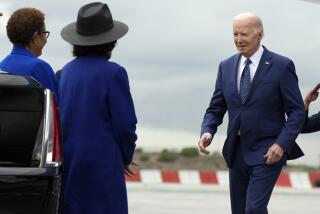Firms Paying Price for U.S. Customs’ Computer Snafu
Continued delays in funding a new computer system for simplifying import accounting and duty collection at the U.S. Customs Service has created a potentially costly dilemma for a number of Southern California’s biggest shippers.
Should local importers continue to shoulder avoidable overhead costs and postpone much-needed improvements on their own foreign-trade computers until Customs replaces its current, antiquated system?
Or should they forge ahead with modernization plans even though new systems installed now could be obsolete once the federal agency powers up its much-anticipated $1.5-billion network known as ACE?
Companies like Toshiba America Electronic Components, headquartered in Irvine, have opted to go forward with upgrades because their former systems hindered efforts to streamline importing and logistics procedures.
But Toshiba and other major importers such as Torrance-based Toyota Motor Sales, which has plunked as much as $80,000 into a new duty reconciliation system, fear they will have to fork over more money for additional upgrades and modifications, perhaps more than they’ve already spent, once ACE is implemented.
“It is obvious this will be costly for us when they do make the change in the future and go to ACE,” said Lisa Cortes, Toshiba’s senior import-export manager. The company is currently in the midst of a $70,000 overhaul of its customs interface system, which Cortes said is necessary to bring it in line with the rest of Toshiba America’s computer network.
Meanwhile, companies such as Irvine-based Mazda North American Operations have decided to put off their own upgrades indefinitely.
“We’re not going to make any improvements on our system until Customs gets its house in order and develops its own system,” said Pedro Villanueva, Mazda North American’s customs manager.
He said the company has decided to shelve plans for a $200,000 to $300,000 overhaul until Customs at least releases a blueprint of how its new system will function. To move forward any earlier, Villanueva said, would be a waste of time and money. “We can’t do anything until we know what Customs is going to come up with for the new interface,” he said.
Trade industry observers say importers across the country find themselves in a similar quandary, but the issue is especially acute in Southern California, home to the nation’s two busiest seaports in Long Beach and Los Angeles, and the world’s third-busiest cargo airport at LAX.
Currently, the Customs Service operates a 17-year-old computer system known as ACS, which is responsible for clearing and processing duties and tariffs on as many as 30,000 import entries a day. The current system, however, is merely an automated version of Customs’ duty-entry filing practices that date to the 18th century.
For volume importers such as Mazda North American, that means filing documentation on as many as 500 cars and countless auto parts shipments entering through five U.S. ports.
In 1994, Congress gave Customs the go-ahead to develop a new streamlined system that would allow importers to file a single duty payment statement once a month for all shipments within a 30-day period. Villanueva estimates that such a practice would save his company untold overhead expenses and as many as 1,200 employee-hours a year. “We could be having our people doing something else,” he said.
For that to happen, though, Customs must replace its current computer network which, given its age and the increasingly arduous task of processing the nation’s growing appetite for imports, has suffered a number of minor crashes over the last two years.
The price tag for the new system, however, has been estimated at $1.5 billion, and getting Congress to allocate the funds has been difficult. In January, for example, Customs Service Commissioner Raymond Kelly pulled the plug on efforts to start the bidding process, citing a lack of funds.
Last year, the Clinton administration proposed adding a user fee that importers would pay to generate funding for the program. Congress, however, balked. This year, the administration called for $210 million to begin the bidding process, but again called for a user fee to offset the cost.
Robin Lanier, a Washington-based consultant to the retail industry on customs issues, sees no political will on Capitol Hill to slap a user fee on importers, but is still “cautiously optimistic” some money will be set aside to get the project off the ground.
More to Read
Inside the business of entertainment
The Wide Shot brings you news, analysis and insights on everything from streaming wars to production — and what it all means for the future.
You may occasionally receive promotional content from the Los Angeles Times.










